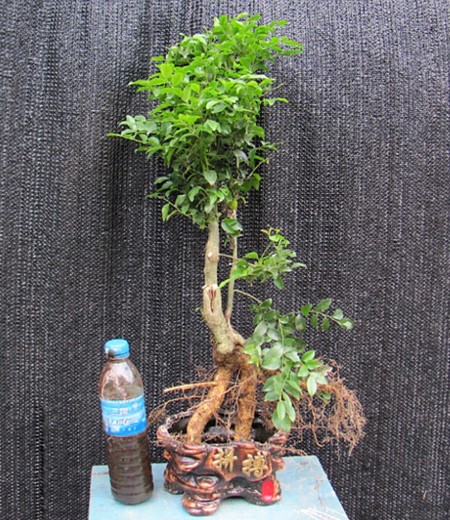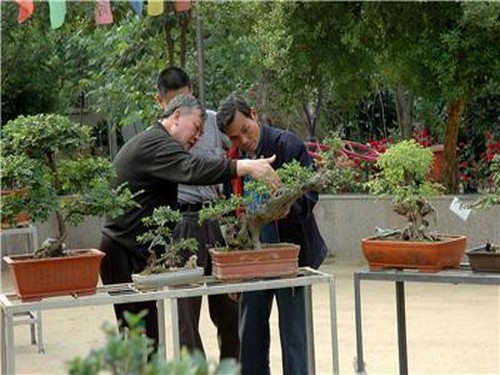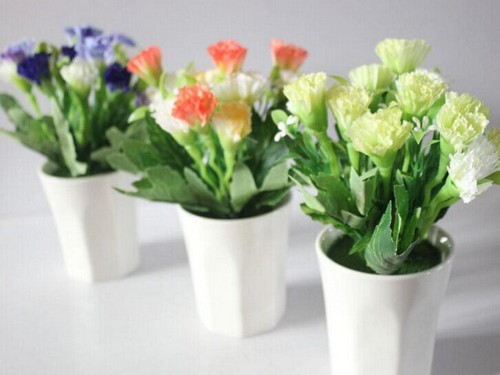Seedling raising technique of lobular privet bonsai
Ligustrum is an evergreen or semi-evergreen shrub belonging to Oleaceae, Ligustrum. Also known as small leaf holly, small ash tree. For garden hedgerow material, can be used as osmanthus, clove and other trees rootstock. Strong, hardy; strong tillering; pruning resistant. Available seeding, cuttage and sub-plant methods of propagation, but mainly to seed propagation.

1. Sowing seedlings:
October to November when the stone fruit is purple black can be harvested, immediately after harvest sowing, but also dry storage to the following March sowing. Soak the seeds in warm water for 1 - 2 days before sowing, and sow them after soaking. Stripe planting, strip spacing 30CM, sowing width 5 - 10CM, depth 2CM, covered with fine soil after sowing, and then covered with straw. Pay attention to watering and keep the soil moist. After the seedlings are unearthed, the straw is gradually removed, and thin fertilizer can be applied when the branches and leaves are slightly unfolded. When the seedling height is 3 - 5CM, the seedling can be thinned and the plant spacing is 10CM. Seedling growth is generally slow, 2 years old can be used as a hedge.
2. Cutting seedlings:
Cutting time in March-April or August-September can be. Spring cutting is to take the first year of winter branches, cut into 15 - 20CM long, and then sand storage, after 3 - 4 months of sand storage, can form healing tissue, to the next spring cutting, it is easier to survive, with naphthylacetic acid after soaking branches to improve the survival rate of about double. Cuttings were 20×30CM in row spacing and 2/3 deep. Water frequently after insertion to maintain proper humidity. The cuttings stored in sand can take root after one month of spring planting. Autumn cuttings cannot take root in that year, only form healing tissue in winter, and can take root in spring of the following year.
After surviving, it is managed for one year, transplanted before germination in spring of the next year, and can be used as rootstock in the third year. If you want to get grafted rootstock one year earlier, you can choose strong annual branches in autumn, cut them into cuttings about 25CM long, and cut them in the spring of the next year according to the plant spacing of 30×30CM after sand storage. They can take root and survive in the same year, and can be used as grafted rootstock in the second year.
3. Plant division and seedling raising. After cutting the roots and tillers in spring, plant them in seedling land and water them when planting. Fourth, tending management Transplantation in spring February to March is appropriate, autumn can also be. It is necessary to bring soil balls, and it should not be too deep when planting. Such as planting, in the bottom of the hole fertilization, promote growth. If it is used as a hedge, it can be properly pruned and attention should be paid to pruning weak and diseased branches. The main pests are green insects, blowing cotton scale insects, etc., to pay attention to prevention and control.
Technical highlights:
Sowing seedlings, choose spring from early March to mid-April sowing. The growing environment is not strict with the soil, as long as it is loose and fertile. Before sowing, the peeled seeds are soaked in warm water for 1 to 2 days, and then sown, drilled or broadcast. The row spacing is 20 cm, the soil covering is 1.5 cm ~2 cm, and the sowing amount per mu is about 7 kg. Because privet germination time is longer, about 1 month, after sowing it is best to cover grass in the ridge to preserve moisture. After the seedlings are unearthed, they should be loosened and weeded in time. When the seedlings are 5 cm high, they should be thinned. If the seedlings are afraid of waterlogging, they should pay attention to drainage. However, irrigation should be carried out when they are too dry. Topdressing should be carried out 1~2 times according to conventional management. Weed once a month. The height of an annual seedling reaches 50 cm. If large seedlings are cultivated, they need to be planted in different beds, and they will be out of the nursery after 2 to 4 years.
Cuttage seedlings, can be cut in November to grow branches buried in spring, the next spring, March out of cuttings, cuttings 0.3 cm ~0.4 cm thick, each ear length of 15~18 cm, the upper end of the mouth flat, the lower end of the mouth inclined, the upper leaves 1~2, the cuttings inserted into the soil 2/3, plant spacing 10 cm, about 2 months after rooting, seedlings up to 70~90 cm.
Time: 2019-06-12 Click:
- Prev

Ligustrum microphylla model tree bonsai
Ligustrum lucidum modeling tree, after artificial shaping and pruning shape, different shapes, mostly multi-spherical or cloud sheet type, 1.2 meters to 3 meters high, clustered or single stem, each plant can have several to more than ten balls (or cloud sheet) its leaf are small, evergreen, resistant to pruning and grow rapidly. potted plants can be made into large, medium and small bonsai
- Next

Propagation method of Carnation
How to breed carnations? How to breed carnations has always been a concern for florists. The propagation of carnations is generally carried out by cutting in early spring. Specific how to breed carnations, flowers in the clouds below will give you a detailed introduction, hoping to help you breed carnations.
Related
- Fuxing push coffee new agricultural production and marketing class: lack of small-scale processing plants
- Jujube rice field leisure farm deep ploughing Yilan for five years to create a space for organic food and play
- Nongyu Farm-A trial of organic papaya for brave women with advanced technology
- Four points for attention in the prevention and control of diseases and insect pests of edible fungi
- How to add nutrient solution to Edible Fungi
- Is there any good way to control edible fungus mites?
- Open Inoculation Technology of Edible Fungi
- Is there any clever way to use fertilizer for edible fungus in winter?
- What agents are used to kill the pathogens of edible fungi in the mushroom shed?
- Rapid drying of Edible Fungi

